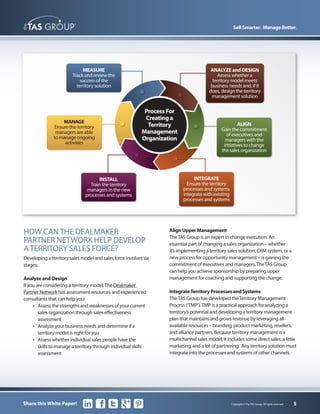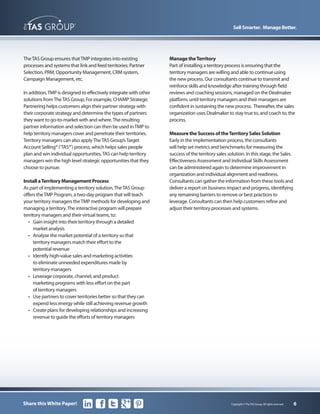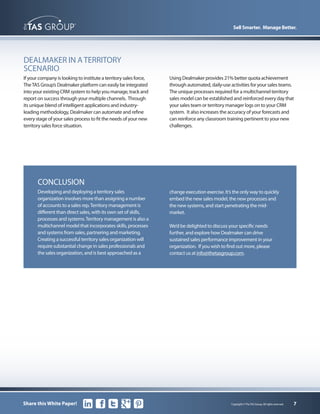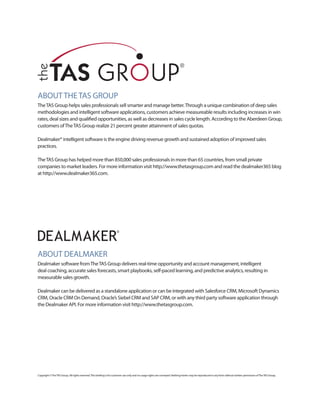Sales White Paper: Executing A Territory Sales Model
- 2. Share this White Paper! Copyright ©TheTAS Group. All rights reserved. 1 Over the last two years, the Company exceeded revenue targets by making a successful strategy to penetrate its top-tier enterprise accounts – the large global accounts that produce most of the Company’s revenue. But that strategy won’t work this year.The Sales executives reviewed the customer metrics and realized that the enterprise accounts don’t have the growth potential to meet the increased sales goals. It’s time to search out new markets. In the past, the Company pretty much ignored the mid-market.There is some real opportunity here if the sales force could penetrate these mid-tier accounts. Direct Selling is Unrealistic in aTerritory The top-tier accounts are limited, but the mid-market is vast. And because the mid-market is so vast, a direct sales approach is unrealistic. Using a direct sales model to adequately penetrate Executing aTerritory Sales Model INTRODUCTION The executives at a major software company have set high revenue goals for the next two years. Currently the Company sells custom and one-off financial software to major Fortune 500 companies. But to meet their aggressive revenue goals, they must diversify their customer base.The Company has decided to expand sales by defining and growing their mid- market business.The strategy is to sell standard versions of their 100 software titles to companies with revenues between $100 and $500 million. Now, it’s up to theVice President of Sales to develop a plan to penetrate these mid-market companies. After reviewing all the various options, theVP of Sales decided to deploy a territory sales force to penetrate the mid-market – a decision that will require changes in the organization, people, processes, and systems. Different skills, different processes – different customers For instance, the current sales force sells face-to-face, dealing with executives and working with complex decision-making processes. But the territory managers have to manage too many accounts to sell to each one personally.The customers are different, too. Instead of giant global corporations with big budgets and time, a territory sales force has to sell to businesses that make $100 million in sales, want proven systems, want them yesterday, and want them cheaper. In addition to lower prices, the customers want an all- inclusive system – they don’t want to ask five suppliers to put together a new system. And, because these companies are smaller, they make decisions quicker. Why did the Company decide to deploy a territory sales force? How should the territories be apportioned? Should the Company convert existing account reps into territory managers? If so, what new skills, process and systems will they need? How do you manage these new types of accounts? As with any of ourWhite Papers, there will be a big variance in the seniority and experience of the readership. ThisWhite Paper aims to provide something for the complete range of requirements, but if you want to dig deeper or move wider, we urge you to get in touch with us individually. You can do this via email to: info@thetasgroup.com. the mid-market would require a very high number of sales people.TheVP of Sales at our example Company knew it was necessary to redefine the sales approach to reach large numbers of mid-sized accounts – without hiring large numbers of sales people. Instead of high touch sales reps, theVP decided to set up territory managers to handle the mid-market accounts. Creating a territory sales force will allow the Company to aggressively create streams of predictable revenue from entire segments of mid- market customers, rather than depending on one or two major competitive wins to make the assigned sales quota.Winning a territory is different than winning big deals.The goal is to grow market share rather than bank on high profile competitive wins. WHY DEPLOY ATERRITORY SALES FORCE?
- 3. Share this White Paper! Copyright ©TheTAS Group. All rights reserved. 2 Further SegmentYourTerritory Even though a market is segmented to create territories, territory managers must further break their territories into bite-sized market pieces.Territory managers use segmenting to help them decide what pieces to go after and how to go after them – essentially, prioritizing activities and allocating resources. For example, if a territory includes the entire San Francisco Bay area, then that territory manager may want to segment the area by vertical markets or size of company. Essentially, a manager will segment a territory based on product offerings and market characteristics – similar to segmenting a market into territories. Market segments are created wherever a product offering intersects with a market characteristic (location, account type, industry, etc.). When the territory is broken into market segments, a territory manager can decide how best to penetrate and cover each group of customers – direct touch (face to face, call center, or telephone), marketing (direct response), web, or through partners. WHAT DOES ATERRITORY LOOK LIKE? Now theVP has to carve up the mid-market into territories. How you delineate territories affects the people, processes and systems you need in order to sell into territories.Typically, a territory is a collection of 50 or more accounts that have some common denominator.The most frequent methods are to carve up the mid-market by geographical location and/or vertical industry: • Geographic territories are defined by some geographic boundary.You can divide territories geographically into as small or as large a geographic region as you want – you may include one city or all of Latin American.The size of the geographic area depends on how many potential customers you have in that area • Vertical territories are divided by industry – for example financial services, software developers, or telecommunications.To make a territory more manageable, a company may wish to combine vertical and geographic criteria. In this case, a territory might include all telecommunications companies in Kansas and Missouri Although defining territories by geography or industry is common, other criteria may be more relevant to this software company.TheVP of Sales should consider segmenting by other, more targeted criteria: • Similar customer needs • Functional divisions (human resources, information technology) • Account type (existing vs. target) • Size of company (based on revenue or potential revenue) • The type of partner you’ll use to sell to the customer – reseller, distributor, software vendor, etc. • The primary competition you’ll sell against Market Segment (Where and What) Market (Where ) Potential Offering (What )
- 4. Share this White Paper! Copyright ©TheTAS Group. All rights reserved. 3 Marketing into a territory differs from corporate marketing. Corporate marketing provides a company with general recognition for a specific capability.Territory marketing must appeal to the specific needs of a segment of accounts. If a territory consists of telecommunications companies in Kansas and Missouri, then that territory’s marketing should be specific to that segment.The goal is to create awareness and interest that drive pull. Most territory managers are inexperienced in marketing, so establishing a clear process can help them develop and implement effective territory marketing plans. Relies on Partnerships In a mid-market sales strategy, partners are necessary to cover the territory and provide a complete solution. Customers in the mid-market want a total solution that requires little configuration because they don’t have the time, money, or people to customize a solution. However, rarely does a single vendor provide an off-the-shelf, total solution.The Software Company may want to partner with aValue Added Reseller (‘VAR’) to provide an integrated, complete solution to their accounts.The territory manager will have to understand: • Who the available partners are • What they are capable of • How to communicate with them to achieve mutual goals • How to best use these partners To accomplish this, the territory manager will need to work closely with the partner organization, which will hopefully have the process and tools in place for effective Partner Relationship Management (‘PRM’). HOW IS SELLINGTOTHE MID-MARKET DIFFERENT? Uses a Multichannel Approach When selling to the mid-market, sales professionals must understand how to use all sales channels effectively – territory managers will not have the time to sit down one-on-one with all of their customers.The best approach is to develop a multichannel strategy for territory management, which may include direct sales, partners (resellers and alliances), marketing, call centers, or the web. A multichannel strategy maximizes penetration of a territory by providing customers many ways to purchase products and services – anywhere, anytime, and anyplace, 24x7. Territory managers must use their resources and channels to position their company’s capabilities quickly and clearly.They have to show customers a picture of what the company can offer and then provide them with several ways of obtaining the solution. How the customer buys is less important in this model. Selling to the mid-market is market driven, not account or deal driven.The goal is to select, focus, and create awareness and interest in the right segments of your territories. Incorporates Marketing Strategies To sell successfully to the mid-market, territory managers must combine marketing and sales strategies.When selling to enterprise accounts a sales force can take a high-touch, consultative, one-to-one approach, but in the mid-market they have to sell one-to-many. Since they cannot physically introduce themselves to all 200 or so customers, they will have to use marketing techniques to obtain the customers’ immediate recognition. Marketing techniques can make a big impact without requiring much time from the sales force.
- 5. Share this White Paper! Copyright ©TheTAS Group. All rights reserved. 4 WHAT ARETHE COMMON MISTAKES COMPANIES MAKEWHEN DEPLOYING ATERRITORY SALES FORCE? One of the biggest mistakes companies make is treating a territory sales force like a direct sales force. Many companies unwittingly do this by continually talking about making deals.Territory managers do not have time to worry about individual deals – they must worry about creating streams of revenue. Another common mistake is not compensating territory managers for using channels. Unlike direct sales, territory managers must use a multichannel strategy to completely penetrate their territory. If you compensate on direct sales, you only get direct sales, which will severely limit territory growth. Finally, many companies fail to develop an execution strategy for the territory sales force.The territory sales force needs: • Guidance from the corporate level • Product strategy information • Market focus/insight into assigned territory • Clear rules of engagement for using a multichannel strategy • An understanding of available resources and how to easily access them WHAT ARETHE ISSUES IN CREATING ATERRITORY SALES FORCE? TheVP of Sales in our example Software Company is tasked with developing a territory sales force but selling to a territory is very different than selling to enterprise accounts.Territory management is an entirely different process from account management.You will have to develop and deploy processes to guide the territory managers as they deal with the issues involved in managing a territory, which include: • Giving up control:Territory managers may not have direct contact with or even direct control over many customers.Territory managers must learn to use multichannel strategies – the web, telesales, partners, marketing – and learn the processes for managing these channels • Defining corporate priorities:Territories contain a multitude of opportunities, so territory managers need help deciding which opportunities are important. Establishing structured processes for segmenting and analyzing territories will help keep the decisions of the territory managers aligned with corporate goals • Developing a strategy:Territory managers have a variety of resources to pull from and many channels to use when taking products to market.They must develop a strategy for penetrating territories – often multiple strategies – that determines what resources work best with what type of customer • Managing time: Perhaps the most difficult thing for a territory manager to learn is how to manage time effectively. Should they spend their time developing marketing programs, helping call center people understand the territory, convincing partners to work with them, or calling on key potential accounts? Prioritizing their activities is critical, so prioritizing opportunities is even more critical Someonewhocancreatelucrativestreamsofrevenuefrom hundredsofcustomers,managetheeffortsofemployees thatdon’treporttoyou,organizemarketingcampaigns withlittlesupportfromthemarketingdepartment,andtap theresourcesofdisinterestedbusinesspartners.Andyou mustbeabletodoallthiswithlimitedtimeandbudget. WANTED: Territory Manager
- 6. Share this White Paper! Copyright ©TheTAS Group. All rights reserved. 5 Align Upper Management TheTAS Group is an expert in change execution. An essential part of changing a sales organization – whether it’s implementing a territory sales solution, CRM system, or a new process for opportunity management – is gaining the commitment of executives and managers.TheTAS Group can help you achieve sponsorship by preparing upper management for coaching and supporting the change. IntegrateTerritory Processes and Systems TheTAS Group has developed theTerritory Management Process (‘TMP’).TMP is a practical approach for analyzing a territory’s potential and developing a territory management plan that maintains and grows revenue by leveraging all available resources – branding, product marketing, resellers, and alliance partners. Because territory management is a multichannel sales model, it includes some direct sales, a little marketing, and a lot of partnering. Any territory solution must integrate into the processes and systems of other channels. HOW CANTHE DEALMAKER PARTNER NETWORK HELP DEVELOP ATERRITORY SALES FORCE? Developing a territory sales model and sales force involves six stages: Analyze and Design If you are considering a territory model,The Dealmaker Partner Network has assessment resources and experienced consultants that can help you: • Assess the strengths and weaknesses of your current sales organization through sales effectiveness assessment • Analyze your business needs and determine if a territory model is right for you • Assess whether individual sales people have the skills to manage a territory through individual skills assessment Process For Creating a Territory Management Organization INTEGRATE Ensure the territory processes and systems integrate with existing processes and systems ALIGN Gain the commitment of executives and managers with the iritiatives to change the sales organization INSTALL Train the territory managers in the new processes and systems MANAGE Ensure the territory managers are able to manage ongoing activities MEASURE Track and review the success of the territory solution ANALYZE and DESIGN Assess whether a territory model meets business needs and, if it does, design the territory management solution
- 7. Share this White Paper! Copyright ©TheTAS Group. All rights reserved. 6 Manage theTerritory Part of installing a territory process is ensuring that the territory managers are willing and able to continue using the new process. Our consultants continue to transmit and reinforce skills and knowledge after training through field reviews and coaching sessions, managed on the Dealmaker platform, until territory managers and their managers are confident in sustaining the new process. Thereafter, the sales organization uses Dealmaker to stay true to, and coach to, the process. Measure the Success of theTerritory Sales Solution Early in the implementation process, the consultants will help set metrics and benchmarks for measuring the success of the territory sales solution. In this stage, the Sales Effectiveness Assessment and Individual Skills Assessment can be administered again to determine improvement in organization and individual alignment and readiness. Consultants can gather the information from these tools and deliver a report on business impact and progress, identifying any remaining barriers to remove or best practices to leverage. Consultants can then help customers refine and adjust their territory processes and systems. TheTAS Group ensures thatTMP integrates into existing processes and systems that link and feed territories: Partner Selection, PRM, Opportunity Management, CRM system, Campaign Management, etc. In addition,TMP is designed to effectively integrate with other solutions fromTheTAS Group. For example, CHAMP Strategic Partnering helps customers align their partner strategy with their corporate strategy and determine the types of partners they want to go-to-market with and where.The resulting partner information and selection can then be used inTMP to help territory managers cover and penetrate their territories. Territory managers can also applyTheTAS Group’sTarget Account Selling® (‘TAS®’) process, which helps sales people plan and win individual opportunities.TAS can help territory managers win the high level strategic opportunities that they choose to pursue. Install aTerritory Management Process As part of implementing a territory solution,TheTAS Group offers theTMP Program, a two-day program that will teach your territory managers theTMP methods for developing and managing a territory.The interactive program will prepare territory managers and their virtual teams, to: • Gain insight into their territory through a detailed market analysis • Analyze the market potential of a territory so that territory managers match their effort to the potential revenue • Identify high-value sales and marketing activities to eliminate unneeded expenditures made by territory managers • Leverage corporate, channel, and product marketing programs with less effort on the part of territory managers • Use partners to cover territories better so that they can expend less energy while still achieving revenue growth • Create plans for developing relationships and increasing revenue to guide the efforts of territory managers
- 8. Share this White Paper! Copyright ©TheTAS Group. All rights reserved. 7 Using Dealmaker provides 21% better quota achievement through automated, daily-use activities for your sales teams. The unique processes required for a multichannel territory sales model can be established and reinforced every day that your sales team or territory manager logs on to your CRM system. It also increases the accuracy of your forecasts and can reinforce any classroom training pertinent to your new challenges. DEALMAKER IN ATERRITORY SCENARIO If your company is looking to institute a territory sales force, TheTAS Group’s Dealmaker platform can easily be integrated into your existing CRM system to help you manage, track and report on success through your multiple channels. Through its unique blend of intelligent applications and industry- leading methodology, Dealmaker can automate and refine every stage of your sales process to fit the needs of your new territory sales force situation. CONCLUSION Developing and deploying a territory sales organization involves more than assigning a number of accounts to a sales rep.Territory management is different than direct sales, with its own set of skills, processes and systems.Territory management is also a multichannel model that incorporates skills, processes and systems from sales, partnering and marketing. Creating a successful territory sales organization will require substantial change in sales professionals and the sales organization, and is best approached as a change execution exercise. It’s the only way to quickly embed the new sales model, the new processes and the new systems, and start penetrating the mid- market. We’d be delighted to discuss your specific needs further, and explore how Dealmaker can drive sustained sales performance improvement in your organization. If you wish to find out more, please contact us at info@thetasgroup.com.
- 9. ABOUTTHETAS GROUP TheTAS Group helps progressive sales organizations increase their sales velocity resulting in higher win rates, bigger deals, shorter sales cycles, and more qualified deals in the pipeline. Our unique value is deep methodology embedded within intelligent Dealmaker software, 100% native in Salesforce. Smart coaching, delivered just-in-time, improves sales performance and accelerates sales results.We have changed the paradigm of improving sales effectiveness from traditional sales training to delivering sales methodology and insights when and where the sales person is working a sales opportunity. For more information visit www.thetasgroup.com Copyright ©TheTAS Group. All rights reserved.This briefing is for customer use only and no usage rights are conveyed. Nothing herein may be reproduced in any form without written permission ofTheTAS Group.









